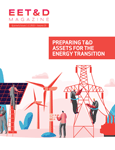Electrification plays a dominant role in our global pursuit of net-zero emissions. The International Energy Agency outlines a narrow path to that goal globally by 2050, naming electrification and renewables as critical components.
In the U.S., the recently passed Infrastructure Bill provides some of the largest funding the transportation and energy sectors have ever received — primarily toward the goal of increasing electrification and renewables. On the wave of this national investment, we’re seeing some of the biggest and most radical changes to the U.S. energy market. By that 2050 goal, the energy market will be vastly different.
Renewables will become an ever-increasing portion of the mix. The ramping up of renewables and the integration of new infrastructure bring extreme challenges to the grid. The real-time supply and demand grid balancing act will become more complex thanks to the influxes of electric vehicles, prosumers and energy storage. It will also significantly influence the economics of our electricity markets. Energy trading is poised to see massive shifts.
Increasing renewables
Last year, for the first time, renewables generated more electricity than fossil fuels in the European Union. By 2050, the U.S. Energy Information Association projects renewables will comprise 42% of electricity generation. Similarly, Japan has set an ambitious target for renewable energy in the nation's electricity mix as it aims to tackle climate change and achieve its 2050 carbon-neutral goal.
The global market demand for renewable energy grows due to governmental programs, corporate sustainability initiatives and “prosumers” choosing green energy. Over 1,000 companies, holding more than $23 trillion in market capitalization, have set 1.5°C-aligned science-based targets for decarbonization.
We are not only witnessing changes in how electricity is produced and consumed, but we're also seeing the way energy is traded. Outputs from wind and solar are less predictable than thermal generators. These renewable sources can lead to either an abundance of generated power at low prices (even negative when the grid can’t absorb the excess) or exactly the opposite when there is less wind or sunshine than forecasted. Then thermal generators are challenged to fill the gap.
Add to this the impact of localized generation on transmission networks, and it’s clear how market positions become more uncertain as renewable energy supply increases. The volatile and intermittent nature of renewable resources introduces rapidly changing market positions, which will move the market to more short-term trading.
However, as renewable energy continues to be promoted as the path to meeting our energy transition goals, any short supply in the market will greatly impact market prices. Energy storage projects alongside an electricity network are necessary to achieve the decarbonization goals that countries have set for themselves.
With outputs from wind and solar being less predictable than thermal generators, batteries are set to become increasingly critical in the power market as backups to supply (discharge) or absorb (charge) electricity. With such a pivotal function, battery storage owners are in a position to take advantage of potential revenue opportunities in an increasingly volatile power market as the share of renewable generation grows.
In addition, decarbonization efforts have created a growing market in green certificates — receiving a boost by the European Union Fit for 55 program as well as the recent report from the Intergovernmental Panel on Climate Change — driving demand for tradable certificates to offset CO2 emissions to prove electricity was generated by a renewable source. These Energy Attribute Certificates — known as Reliable Energy Certificates (REC) in North America and Guarantee of Origin (GOO) in Europe — also include Energy Saving Certificates, or white certificates, and can cover both power and biogas. Managing this increased volume requires new solutions to manage risk, financial and compliance reporting. Moreover, new consumer and business demands are calling for support of business scenarios to serve their needs for trade-to-trade matching, peer-to-peer matching of electricity deals (B2B and B2C) with a desired set of certificates. As a result, wholesale market participants are facing increased complexity — necessitating automation and market integration.
Unpredictable, extreme events
In addition to increased renewables, extreme and unpredictable events (such as the bankruptcy of Enron and the California energy crisis in 2001) have rocked the electricity landscape throughout history and seem to be occurring with increased frequency. More recent events include the COVID-19 induced national lockdowns, failing retail energy suppliers in the United Kingdom, Texas’ February 2021 freeze leaving millions without power and the E.U.’s plan to cut emissions by 55%. These have all presented energy players with some of the most extreme supply and demand shocks ever seen. This doesn’t even incorporate extreme weather events, from hurricanes to fires, that have stressed the system.
With this shift from legacy energy commodities to next-generation renewables, it is time for energy companies to consider doing the same with their systems and develop core competencies that support their activities around cleaner energies. Market participants are increasingly tasked with developing a sound energy portfolio management strategy but are challenged by legacy technology and processes not equipped to support the operations in a renewable energy market.
To be successful, companies need to constantly evaluate markets to understand the effects of tightening regulations, resource constraints, market volatility and environmental pressures. Considering the complex nature of today’s energy markets, the process of gathering, modeling and analyzing data to produce good intelligence, is a resource-intensive but crucial task needed to operate in a competitive market.
Evolving electricity markets
As the electricity landscape continues to transition and evolve, a new market landscape is emerging. It addresses the primary question: how can a reliable and resilient grid be maintained while simultaneously onboarding and adequately compensating flexible resources?
In the U.S., the Federal Energy Regulatory Commission (FERC) has focused a great deal on this topic. It aims to address the challenges and opportunities of optimizing energy and ancillary services markets. Recent meetings highlighted the importance of how new modern electricity market design is needed to accommodate the rapid changes occurring across the power industry. The combination of diverse energy resources — capacity, and fast-responding flexible resources such as quick-responding natural gas turbines, energy storage and new technologies to improve power quality — are paramount to keeping the lights on. This also includes ways to relieve the power distribution grid. As smaller renewable generators, as well as residential generation, seek access to the market to sell production or surplus production, smaller companies need affordable and easy access to green power. Individual prosumers can relieve constraints on the power grids through peer-to-peer electricity trading without the need for an intermediary.
Similar discussions with varying levels of implementation are being held around the world.
This is indeed a challenge. However, although the volatility and shorter-term and intraday trading create more risk and complexity for traders, they also bring increased opportunities. The key lies in how to best leverage those opportunities.
Preparing for change
As the energy transition continues, utilities will have to adapt their grids and ready their infrastructure to take on more renewables, diversified/distributed generators, electric vehicles and storage. In addition, they’ll need to prepare for new market entrants, such as renewable energy investors who need to equip themselves to own and operate their generation assets. Participating in the wholesale market means they subject themselves to wholesale electricity prices. This, by definition, increases their risk exposure. However, the ability to manage this risk is key to maintaining a competitive position.
These market participants will also need to look at how they can successfully navigate an evolving and dynamic market landscape. A key element to how they will do this starts with the adoption of a sound, forward-looking energy portfolio management strategy that is supported by innovative digital tools.
Broadly speaking, portfolio management is an interplay between electric market simulation, actionable energy market intelligence, optimization of generation resources and portfolios into solution models. It also includes forecasting of prices, load, and generation, as well as energy trading and risk management and communication interfaces with market operators. When all of these components are integrated into a comprehensive portfolio management strategy, planners, portfolio managers, traders and investors can make better economic and strategic decisions that support effective operations.
Companies continue to rely on manual processes and spreadsheets to track their market access activities. Yet, manual and unintegrated system processes can no longer handle the complex and varied nature of all of the components. Unintegrated systems lack the visibility and risk controls necessary for effective portfolio management and optimization. Market participants need and crave digital technology to handle today’s dynamic and complex market environment.
A real-time integrated Commodity/Energy Trading and Risk Management (C/ETRM) system automates bid-to-bill business processes that support the forecasting and optimization of trade cycles from deal capture and contract management to market integration. Market participants can use these digital solutions to tackle everything from pricing and complex fees, trade confirmations, portfolio management and valuations, environmental product optimization, risk controls, collateral and credit management, to settlement and regulatory compliance reporting.
With the advancement of renewable energy, I’m seeing portfolio management now involves capturing, tracking and redeeming certificates either related to emission allowances, such as Verified Emission Reduction (VER) certificates, or related to Energy Attribute Certificates, such as GOO certificates. These are tradable products, and while the capture of purchase or sale of these certificates is straightforward, the inventory management, expiration and cancellation are more complex.
The volume of these certificates is increasing due to more organizations and individuals looking to reduce their environmental footprint. This in turn increases the demand for renewable energy, which will impact price development and risk exposures and add complexity in environmental product optimization and compliances in multiple jurisdictions. Specialized C/ETRM systems to address these new certificates and market shifts are becoming a necessary part of an overall energy portfolio management solution.
Volatility and shorter-term and intraday trading will certainly provide traders increased opportunities but, at the same time, it gives rise to greater risk exposure. Market participants need to be able to track positions and risk exposures in real time – not only to monitor risk but also to trade opportunistically. The technology behind C/ETRM systems is catching up to the energy transition. The market participants engaging in sophisticated energy contracting and trading transactions to serve their load efficiently, profitably and in a balanced fashion on a real-time basis are using a robust and integrated real-time solution.
Today, every organization needs to disrupt or be disrupted. Market participants have little choice but to shake up their operations, reinvent and reposition themselves to find new growth categories by embracing disruption and innovation.
To prevent this wave from dragging you under and to defend your business, your revenue generation operations must run optimally. Productivity-enabling technology is the key tactic to modernize the operating model. Accelerating the energy transition will require changes in electricity markets. We’ll see a higher share of variable renewables such as wind and solar, as well as more distributed power generation. Beyond adapting to these changes, utilities will also need to be prepared for an increasing number of unanticipated, extreme events. An agile approach can help utilities and energy companies to meet and respond to these rapidly changing conditions from both grid operations and a wholesale power market perspective.
The key to successful, nimble navigation of this changing market landscape, now and into the future, lies in successfully anticipating and sorting through market changes, like smaller renewable generators and leveraging batteries in EVs. It also requires the expansion of C/ETRM technology, purpose built for this new market to take advantage of new certificates and trading opportunities. The electrification and renewable energy revolution has already begun – it’s important to stay ahead of the changes it will bring.

Uday Baral is the head of Global Energy Portfolio Management at Hitachi Energy and brings almost two decades of energy and commodities trading experience to his position. He previously founded Pioneer Solutions, a provider of industry-leading front-to-back-office Commodities/Energy Trading and Risk Management (C/ETRM) solutions, which Hitachi Energy acquired in 2020.






